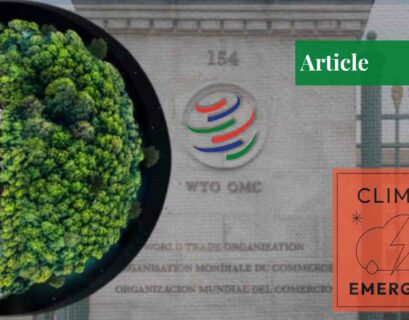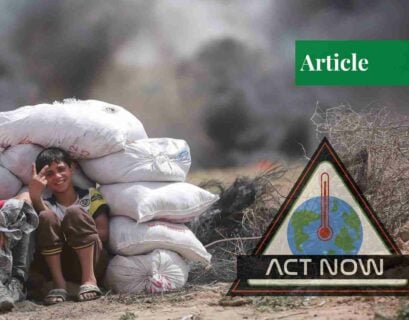Wajeeha Amin is a student of the Department of Defence & Strategic Studies at Quaid-i-Azam University, Islamabad.
Introduction
Arms control and climate change are two of the most pressing issues since the outbreak of the Cold War. Despite their apparent differences, these issues pose a threat to both human security and the overall well-being of the entire globe. Addressing the impact of military activities on climate change offers the chance for a holistic strategy that supports sustainability and security. As former UN Secretary-General Ban Ki-moon said, “We cannot afford to focus on one challenge to the future of our planet at the expense of the other. We need to address both climate change and nuclear weapons proliferation if we want to leave a safe and secure world for our children.”
The junction of these two important topics is explored in this article, emphasizing the possibility of cooperation and the advantages of pursuing a shared objective. As we all know, climate change is producing an array of numerous challenges i.e., increased resource rivalry, widespread migration, and political instability, and it is not wrong if we say that arms races play a vital role in addressing these challenges. These problems could lead to war, which might call for the deployment of nuclear weapons. According to a study by the Stockholm International Peace Research Institute, nuclear war is more likely to occur in nations that are struggling with climate change. Hence, arms control agreements can reduce the likelihood that nuclear weapons will be used.
Military Operations and Climate Impacts
Military operations can have enormous and far-reaching effects on the environment, despite the fact that they are frequently necessary for maintaining national security and defense. The degradation of the environment is a result of the significant assets needed for military operations, the development and use of weapons, and the administration of military facilities.
The military is a significant consumer of energy, mainly the type derived from fossil fuels. It produces a sizable amount of hazardous waste, including depleted uranium, which harms ecosystems and human health. On the other hand, deforestation is frequently a result of military training exercises and installations, which may damage habitats and interfere with wildlife migration routes. Military operations also have a tendency to release contaminants such as heavy metals and chemicals that directly endanger aquatic ecosystems and strain water supplies in areas where there is already a shortage of water, leading to tensions between military bases and local communities.
Linking Defense Budget and Climate Change
The relationship between military expenditures and climate change is complex and includes a number of issues regarding resource allocation, political objectives, and global environmental problems. Greenhouse gases like carbon dioxide, methane, and nitrous oxide are produced during military operations. These gases cause the atmosphere to retain heat, which causes climate change. For instance, the US military produced 143 million tons of carbon dioxide in 2021, making it the highest emitter of greenhouse gases globally. This equates to 100 million automobiles’ worth of pollution. Military activities also require a huge number of resources, which directly leads to resource depletion and scarcity.
A nation may have less money available to address the problems of climate change if it devotes a significant percentage of its budget to defense. Investments in sustainable development, environmental preservation, and clean energy may be constrained as a result. On the other side, money allocated for defense may be used on innovations that have both military and environmental uses, such as cutting-edge satellite systems for tracking weather patterns. Additionally, military troops would be required to handle such circumstances if resource scarcity and potential conflicts are brought on by climate change. So a balance between these aspects should be ensured for a secure and sustainable future.
Diverting Funds: Defense Modernization vs Climate Solutions
Diverting funds from defense modernization to climate solutions and vice versa is very critical because both are important aspects. The military serves the purpose of ensuring the security of a country, whereas, climate change poses a major threat to the globe. For example, Although the United States has a huge defense budget of over $753.5 billion, it has recently increased its investments in climate-related projects. This includes support for research into renewable energy sources and global climate agreements like the Paris Agreement.

Similarly, China has a $252 billion defense budget, but it has also pledged to become carbon neutral by 2060 and has made significant investments in renewable energy sources like solar and wind power. Hence, there should be a balanced budget between the military and climate initiatives because when money is diverted for military modernization, it signifies that it is being utilized to create new defense-related technologies, equipment, and weaponry.
While this may result in a military that is more powerful and technologically advanced, it also implies that less money is available to deal with pressing environmental problems like lowering carbon emissions or preserving natural habitats from floods and earthquakes. Therefore, choosing between short-term security concerns and long-term environmental sustainability when allocating resources to modernization or climate solutions represents a trade-off. So maintaining defense capabilities and taking steps to save the environment for both the present and future generations require balance.
Nuclear Weapons and Environmental Threats
Due to their potential for catastrophic destruction and long-lasting radioactive fallout, nuclear weapons pose a specific and severe threat to the environment. Nuclear weapons explode with powerful blast waves and fireballs that can have both short-term and long-term effects on ecosystems, climate, and human health. For instance, the bombings of Hiroshima and Nagasaki in 1945 caused immense destruction and rapid devastation, killing thousands of people. On the other hand, radioactive particles are released into the atmosphere during nuclear explosions, where they can be spread across large areas by the wind. For instance, the Chernobyl tragedy in 1986 caused extensive pollution by releasing radioactive elements into the atmosphere.

In addition to disrupting ecosystems, nuclear explosions can also cause habitat devastation, biodiversity loss, and long-term genetic harm to both plants and animals. The radioactive contamination of the area brought on by Soviet nuclear testing at the Semipalatinsk Test Site in Kazakhstan has an impact on ecosystems and human health. Additionally, generations’ worth of people may have higher rates of cancer, genetic abnormalities, and other health issues as a result of exposure to nuclear fallout. For instance, research on Japanese atomic bomb survivors has revealed heightened cancer rates and other radiation-related health issues.
Disarmament as a method of reducing climate change goes beyond traditional methods of doing so. Disarmament aids in global attempts to reduce climate change while fostering peace, security, and international cooperation by lowering military activity and reallocating resources towards sustainable development and environmental preservation. The role of disarmament in reducing greenhouse gas emissions is becoming more and more crucial as governments realize how intertwined environmental health, environmental security, and peace are.
Arms Control Agreement and Climate Goals
Arms control agreements and treaties also help to accomplish larger climate goals by minimizing the environmental impact of military operations in order to improve global security. The Conventional Armed Forces in Europe (CFE) Treaty, for example, helped to reduce the environmental impact of a military presence in Europe by requiring the withdrawal and destruction of thousands of pieces of military equipment. Arms control agreements frequently include provisions for the reduction and elimination of specific weapon systems and may result in lower defense spending, freeing up funds that may be used for sustainable development projects.
For instance, the Comprehensive Nuclear Test Ban Treaty (CTBT) and the possibility of global disarmament it offers could reroute funding from the development of nuclear weapons to initiatives that promote climate change. Arms control agreements contribute to lessening tensions and potential conflicts between nations and foster an environment of diplomacy and international cooperation. It lays the groundwork for cooperation on other major global issues like environmental preservation and climate change.
These agreements indirectly lessen the environmental harm brought on by military operations during times of war by avoiding conflicts. They foster a climate of international cooperation and diplomacy to create a model for cooperation on other world issues, such as climate change and environmental protection.
Challenges and Future
Prioritizing between immediate security concerns and longer-term environmental issues can be difficult for governments because there is a lot of competition and mistrust in the international world which leads some nations to place more importance on their own national security and defense than on global collaboration on issues like climate change and arms control. Reliable verification systems and international trust are essential for effective weapons control because building and retaining confidence can be difficult in a time of escalating geopolitical tensions, which makes talks and agreements harder.
Despite ongoing challenges, there is optimism for future cooperation between arms control and climate change initiatives. Collaboration is required to address the pressing issues facing the world, and inventive solutions might come from aligned interests. There is a chance that governments, international organizations, civil society, and individuals may work together to solve both weapons control and climate change as governments, civil society, and individuals increasingly recognize the interconnectedness of security and sustainability.
If you want to submit your articles and/or research papers, please check the Submissions page.
The views and opinions expressed in this article/paper are the author’s own and do not necessarily reflect the editorial position of Paradigm Shift.


















